BSS045-3 Project Proposal: Management Behavior & Employee Satisfaction
VerifiedAdded on 2023/06/14
|10
|2618
|145
Project
AI Summary
This research proposal outlines a project to evaluate management behavior and its impact on employee satisfaction during the Covid-19 crisis. It includes an overview of the project's context, aims, and objectives, along with research questions addressing business needs, employee behavior, and strategies for improvement. A brief literature review examines existing theories and research on management behavior and employee satisfaction, particularly in the context of the pandemic. The methodology section details the research approach (inductive), data collection methods (primary and secondary), sampling techniques (simple random sampling), and data analysis techniques (qualitative thematic analysis). Potential outcomes include insights into how management behavior affects employee productivity and satisfaction during crises, along with recommendations for improving management practices. The proposal also includes a conceptual map, Gantt chart, and risk register to guide the research process. Desklib provides access to this and other solved assignments.
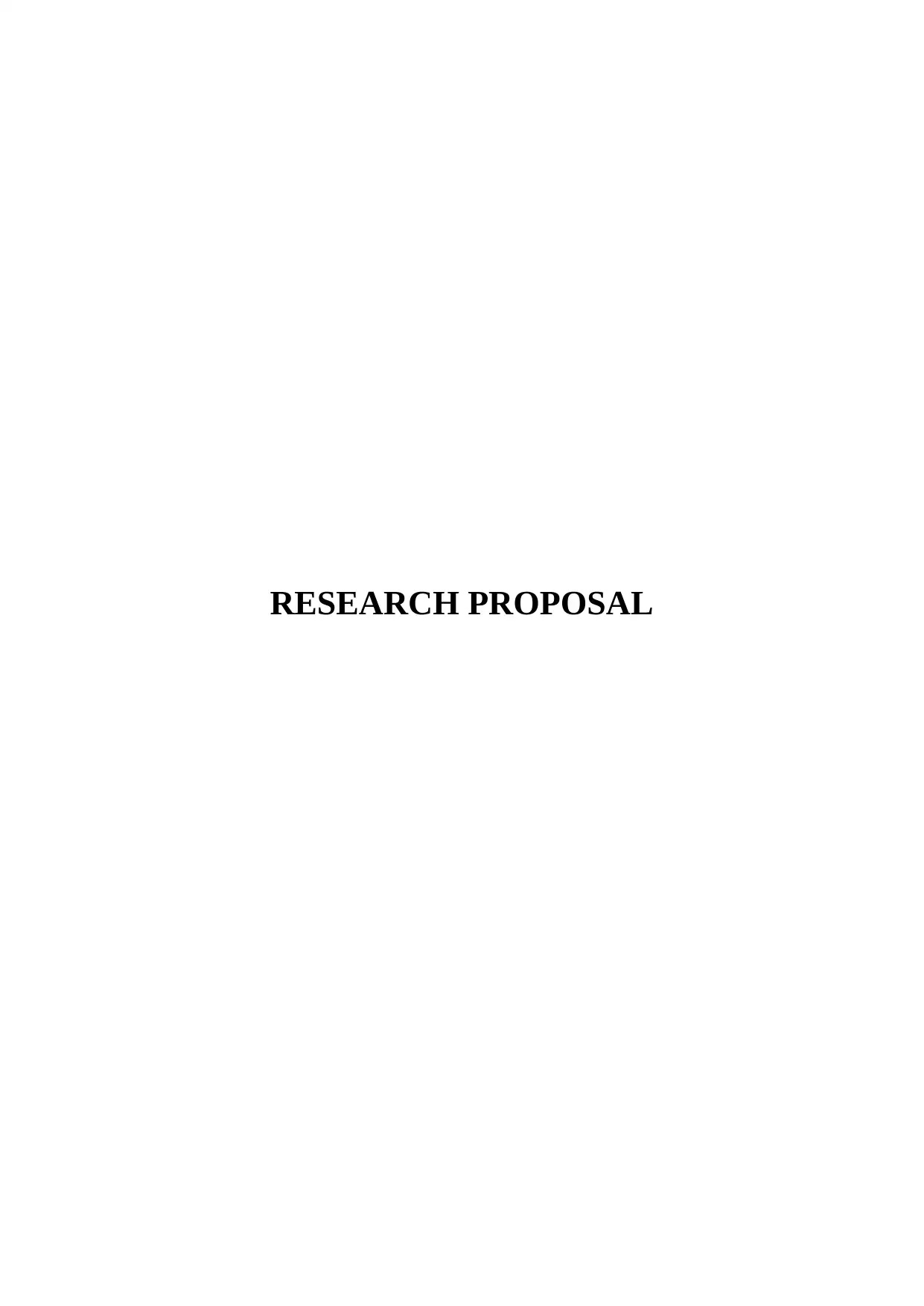
RESEARCH PROPOSAL
Paraphrase This Document
Need a fresh take? Get an instant paraphrase of this document with our AI Paraphraser

CONTENTS
INTRODUCTION TO THE PROJECT.....................................................................................1
Overview................................................................................................................................1
Context of the study................................................................................................................1
Aim and objectives.................................................................................................................2
Research questions.................................................................................................................2
BREIF LITERATURE REVIEW..............................................................................................2
METHODOLOGY.....................................................................................................................4
Research approach..................................................................................................................4
Data collection methods.........................................................................................................4
Sampling.................................................................................................................................4
Data analysis technique..........................................................................................................4
POTENTIAL OUTCOMES.......................................................................................................5
CONCEPTUAL MAP OUTLINING THE CONCEPT OF THE LITERATURE REVIEW....5
GANTT CHART........................................................................................................................5
RISK REGISTER.......................................................................................................................6
REFERENCES...........................................................................................................................8
INTRODUCTION TO THE PROJECT.....................................................................................1
Overview................................................................................................................................1
Context of the study................................................................................................................1
Aim and objectives.................................................................................................................2
Research questions.................................................................................................................2
BREIF LITERATURE REVIEW..............................................................................................2
METHODOLOGY.....................................................................................................................4
Research approach..................................................................................................................4
Data collection methods.........................................................................................................4
Sampling.................................................................................................................................4
Data analysis technique..........................................................................................................4
POTENTIAL OUTCOMES.......................................................................................................5
CONCEPTUAL MAP OUTLINING THE CONCEPT OF THE LITERATURE REVIEW....5
GANTT CHART........................................................................................................................5
RISK REGISTER.......................................................................................................................6
REFERENCES...........................................................................................................................8
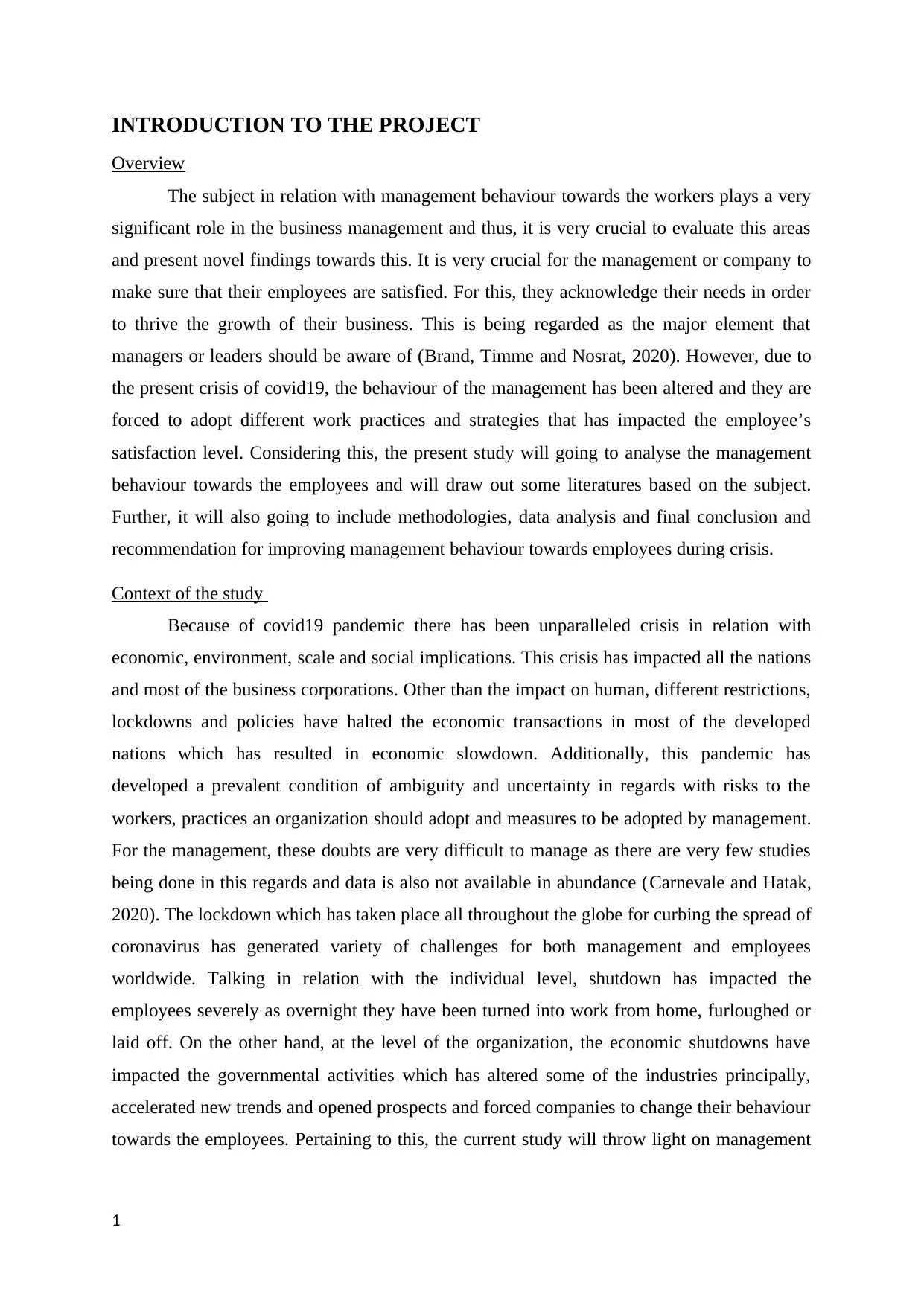
INTRODUCTION TO THE PROJECT
Overview
The subject in relation with management behaviour towards the workers plays a very
significant role in the business management and thus, it is very crucial to evaluate this areas
and present novel findings towards this. It is very crucial for the management or company to
make sure that their employees are satisfied. For this, they acknowledge their needs in order
to thrive the growth of their business. This is being regarded as the major element that
managers or leaders should be aware of (Brand, Timme and Nosrat, 2020). However, due to
the present crisis of covid19, the behaviour of the management has been altered and they are
forced to adopt different work practices and strategies that has impacted the employee’s
satisfaction level. Considering this, the present study will going to analyse the management
behaviour towards the employees and will draw out some literatures based on the subject.
Further, it will also going to include methodologies, data analysis and final conclusion and
recommendation for improving management behaviour towards employees during crisis.
Context of the study
Because of covid19 pandemic there has been unparalleled crisis in relation with
economic, environment, scale and social implications. This crisis has impacted all the nations
and most of the business corporations. Other than the impact on human, different restrictions,
lockdowns and policies have halted the economic transactions in most of the developed
nations which has resulted in economic slowdown. Additionally, this pandemic has
developed a prevalent condition of ambiguity and uncertainty in regards with risks to the
workers, practices an organization should adopt and measures to be adopted by management.
For the management, these doubts are very difficult to manage as there are very few studies
being done in this regards and data is also not available in abundance (Carnevale and Hatak,
2020). The lockdown which has taken place all throughout the globe for curbing the spread of
coronavirus has generated variety of challenges for both management and employees
worldwide. Talking in relation with the individual level, shutdown has impacted the
employees severely as overnight they have been turned into work from home, furloughed or
laid off. On the other hand, at the level of the organization, the economic shutdowns have
impacted the governmental activities which has altered some of the industries principally,
accelerated new trends and opened prospects and forced companies to change their behaviour
towards the employees. Pertaining to this, the current study will throw light on management
1
Overview
The subject in relation with management behaviour towards the workers plays a very
significant role in the business management and thus, it is very crucial to evaluate this areas
and present novel findings towards this. It is very crucial for the management or company to
make sure that their employees are satisfied. For this, they acknowledge their needs in order
to thrive the growth of their business. This is being regarded as the major element that
managers or leaders should be aware of (Brand, Timme and Nosrat, 2020). However, due to
the present crisis of covid19, the behaviour of the management has been altered and they are
forced to adopt different work practices and strategies that has impacted the employee’s
satisfaction level. Considering this, the present study will going to analyse the management
behaviour towards the employees and will draw out some literatures based on the subject.
Further, it will also going to include methodologies, data analysis and final conclusion and
recommendation for improving management behaviour towards employees during crisis.
Context of the study
Because of covid19 pandemic there has been unparalleled crisis in relation with
economic, environment, scale and social implications. This crisis has impacted all the nations
and most of the business corporations. Other than the impact on human, different restrictions,
lockdowns and policies have halted the economic transactions in most of the developed
nations which has resulted in economic slowdown. Additionally, this pandemic has
developed a prevalent condition of ambiguity and uncertainty in regards with risks to the
workers, practices an organization should adopt and measures to be adopted by management.
For the management, these doubts are very difficult to manage as there are very few studies
being done in this regards and data is also not available in abundance (Carnevale and Hatak,
2020). The lockdown which has taken place all throughout the globe for curbing the spread of
coronavirus has generated variety of challenges for both management and employees
worldwide. Talking in relation with the individual level, shutdown has impacted the
employees severely as overnight they have been turned into work from home, furloughed or
laid off. On the other hand, at the level of the organization, the economic shutdowns have
impacted the governmental activities which has altered some of the industries principally,
accelerated new trends and opened prospects and forced companies to change their behaviour
towards the employees. Pertaining to this, the current study will throw light on management
1
⊘ This is a preview!⊘
Do you want full access?
Subscribe today to unlock all pages.

Trusted by 1+ million students worldwide

behaviour towards the employees and how it impacts their satisfaction level during the crisis
period.
Aim and objectives
The main aim of the current research is to evaluate the weaknesses of management
behaviour and its impact on employee’s satisfaction level and determine the business needs
and employee behaviour during the crisis period. To fulfil this aim, there is a requirement of
certain objectives and these are as follows:
To determine the business needs and employee behaviour during the crisis
To analyse the impact of management behaviour on satisfaction level of the
employees
To recommend strategies for improving management behaviour towards employees
during a crisis period
Research questions
What are the business needs and employee behaviour during the crisis?
What is the impact of management behaviour on satisfaction level of the employees?
Which strategies can be used for improving management behaviour towards
employees during a crisis period?
BREIF LITERATURE REVIEW
Management behaviour towards employee is being regarded as an important
component of business management. According to Callahan, Fleenor and Kudson (2016),
management behaviour is nothing but a sub-category of management activities which are
related with the comprehension, prediction and motivating the behaviour of individual in any
organization. Furthermore, as per Steers and Stewart (2017), it is being referred as that
branch of the social sciences that looks for building theories which can be applicable in
predicting, comprehending as well as controlling the behaviour of the workers in the
companies. The significance of the current subject of research is being derived from the
significance of making sure satisfaction of the employees by acknowledging their needs for
the business to thrive. For example, considering the behavioural management theory, it is
most of the time being referred as a human relation movement as it helps in addressing the
human element of work. The behavioural management theory believes that if human
behaviour is better understood by the manager or leader at work such as their motivation
2
period.
Aim and objectives
The main aim of the current research is to evaluate the weaknesses of management
behaviour and its impact on employee’s satisfaction level and determine the business needs
and employee behaviour during the crisis period. To fulfil this aim, there is a requirement of
certain objectives and these are as follows:
To determine the business needs and employee behaviour during the crisis
To analyse the impact of management behaviour on satisfaction level of the
employees
To recommend strategies for improving management behaviour towards employees
during a crisis period
Research questions
What are the business needs and employee behaviour during the crisis?
What is the impact of management behaviour on satisfaction level of the employees?
Which strategies can be used for improving management behaviour towards
employees during a crisis period?
BREIF LITERATURE REVIEW
Management behaviour towards employee is being regarded as an important
component of business management. According to Callahan, Fleenor and Kudson (2016),
management behaviour is nothing but a sub-category of management activities which are
related with the comprehension, prediction and motivating the behaviour of individual in any
organization. Furthermore, as per Steers and Stewart (2017), it is being referred as that
branch of the social sciences that looks for building theories which can be applicable in
predicting, comprehending as well as controlling the behaviour of the workers in the
companies. The significance of the current subject of research is being derived from the
significance of making sure satisfaction of the employees by acknowledging their needs for
the business to thrive. For example, considering the behavioural management theory, it is
most of the time being referred as a human relation movement as it helps in addressing the
human element of work. The behavioural management theory believes that if human
behaviour is better understood by the manager or leader at work such as their motivation
2
Paraphrase This Document
Need a fresh take? Get an instant paraphrase of this document with our AI Paraphraser
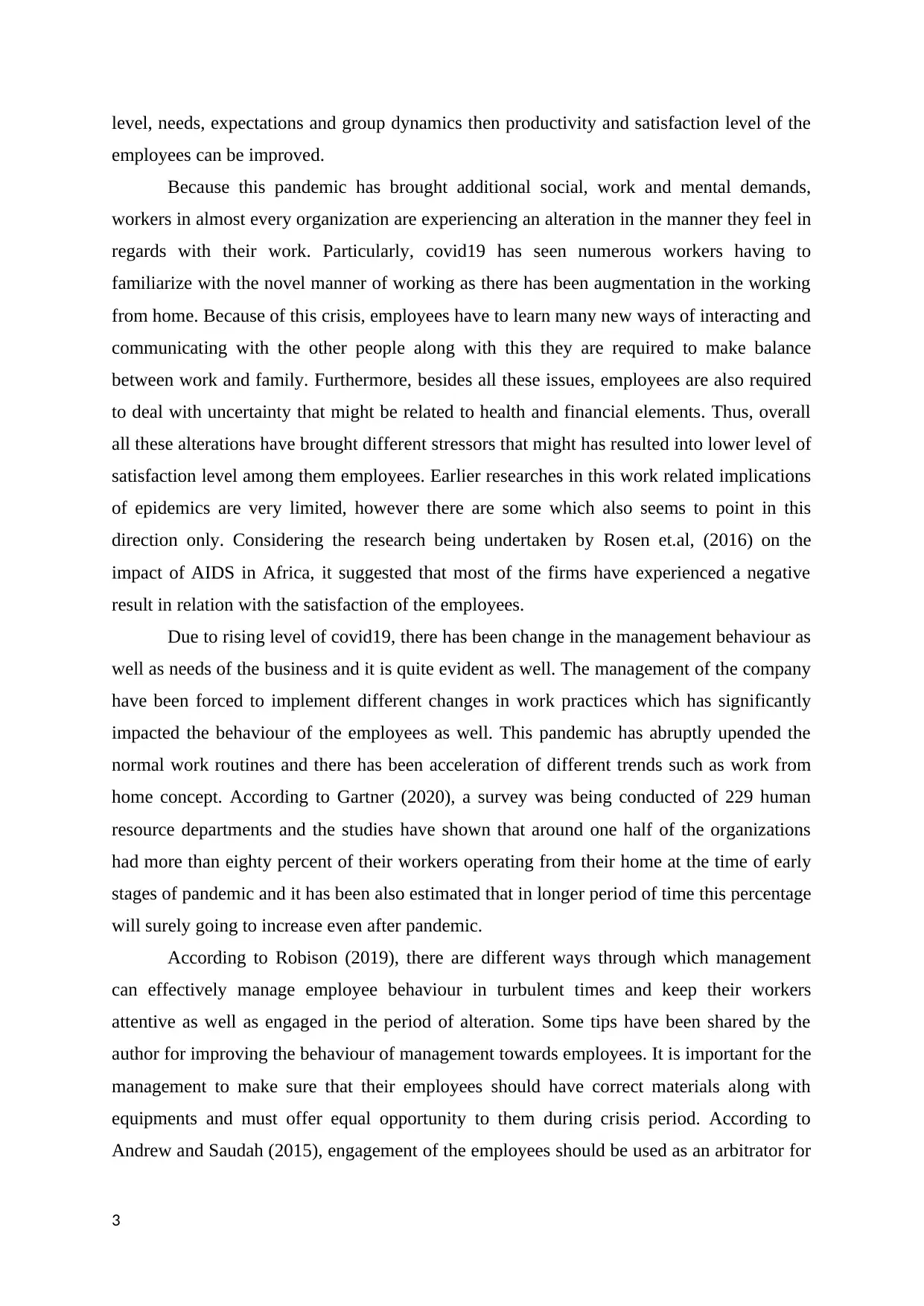
level, needs, expectations and group dynamics then productivity and satisfaction level of the
employees can be improved.
Because this pandemic has brought additional social, work and mental demands,
workers in almost every organization are experiencing an alteration in the manner they feel in
regards with their work. Particularly, covid19 has seen numerous workers having to
familiarize with the novel manner of working as there has been augmentation in the working
from home. Because of this crisis, employees have to learn many new ways of interacting and
communicating with the other people along with this they are required to make balance
between work and family. Furthermore, besides all these issues, employees are also required
to deal with uncertainty that might be related to health and financial elements. Thus, overall
all these alterations have brought different stressors that might has resulted into lower level of
satisfaction level among them employees. Earlier researches in this work related implications
of epidemics are very limited, however there are some which also seems to point in this
direction only. Considering the research being undertaken by Rosen et.al, (2016) on the
impact of AIDS in Africa, it suggested that most of the firms have experienced a negative
result in relation with the satisfaction of the employees.
Due to rising level of covid19, there has been change in the management behaviour as
well as needs of the business and it is quite evident as well. The management of the company
have been forced to implement different changes in work practices which has significantly
impacted the behaviour of the employees as well. This pandemic has abruptly upended the
normal work routines and there has been acceleration of different trends such as work from
home concept. According to Gartner (2020), a survey was being conducted of 229 human
resource departments and the studies have shown that around one half of the organizations
had more than eighty percent of their workers operating from their home at the time of early
stages of pandemic and it has been also estimated that in longer period of time this percentage
will surely going to increase even after pandemic.
According to Robison (2019), there are different ways through which management
can effectively manage employee behaviour in turbulent times and keep their workers
attentive as well as engaged in the period of alteration. Some tips have been shared by the
author for improving the behaviour of management towards employees. It is important for the
management to make sure that their employees should have correct materials along with
equipments and must offer equal opportunity to them during crisis period. According to
Andrew and Saudah (2015), engagement of the employees should be used as an arbitrator for
3
employees can be improved.
Because this pandemic has brought additional social, work and mental demands,
workers in almost every organization are experiencing an alteration in the manner they feel in
regards with their work. Particularly, covid19 has seen numerous workers having to
familiarize with the novel manner of working as there has been augmentation in the working
from home. Because of this crisis, employees have to learn many new ways of interacting and
communicating with the other people along with this they are required to make balance
between work and family. Furthermore, besides all these issues, employees are also required
to deal with uncertainty that might be related to health and financial elements. Thus, overall
all these alterations have brought different stressors that might has resulted into lower level of
satisfaction level among them employees. Earlier researches in this work related implications
of epidemics are very limited, however there are some which also seems to point in this
direction only. Considering the research being undertaken by Rosen et.al, (2016) on the
impact of AIDS in Africa, it suggested that most of the firms have experienced a negative
result in relation with the satisfaction of the employees.
Due to rising level of covid19, there has been change in the management behaviour as
well as needs of the business and it is quite evident as well. The management of the company
have been forced to implement different changes in work practices which has significantly
impacted the behaviour of the employees as well. This pandemic has abruptly upended the
normal work routines and there has been acceleration of different trends such as work from
home concept. According to Gartner (2020), a survey was being conducted of 229 human
resource departments and the studies have shown that around one half of the organizations
had more than eighty percent of their workers operating from their home at the time of early
stages of pandemic and it has been also estimated that in longer period of time this percentage
will surely going to increase even after pandemic.
According to Robison (2019), there are different ways through which management
can effectively manage employee behaviour in turbulent times and keep their workers
attentive as well as engaged in the period of alteration. Some tips have been shared by the
author for improving the behaviour of management towards employees. It is important for the
management to make sure that their employees should have correct materials along with
equipments and must offer equal opportunity to them during crisis period. According to
Andrew and Saudah (2015), engagement of the employees should be used as an arbitrator for
3

enhancing the behaviour of the workers, their intention plus attitudes in regards with better
performance level at workplace.
METHODOLOGY
Research approach
Research approach is being defined as a general plan as well as procedure for carrying
out the whole research work. There are two main types of research approaches that is
deductive and inductive. Inductive approach is referred as the type of approach which does
not involve formulation of hypothesis and generally starts with research questions, research
aims and objectives (Bajpai, 2016). On the other hand, deductive approach involves
formulation of hypothesis. Concerning the present research work, inductive approach will be
utilized as it involves formulation of research questions and then moving towards theory and
conclusions.
Data collection methods
Data collection is the process of collecting information in relation with the topic of the
research study. There are two types of data that is primary and secondary. Primary data is
collected for the first time and secondary data involves exploration of already existing
information. In the current research, both types of data collection methods will be used.
Primary data will be collected by conducting survey of employees in the company (Saunders,
Lewis and Thornhill, 2015). Further, a survey will be carried out through seeking help from
questionnaire which will be sent via emails to large pool of employees. This method is being
selected as it will be more convenient for both the researcher and participants of the survey.
On the other hand, secondary data will be gathered through exploring different journals,
articles and scholarly paper concerning the research topic.
Sampling
For collecting the samples, the researcher will going to make use of simple random
sampling method. Other than this, a sample of 30 employees will be selected for gaining
adequate information through questionnaire. These samples will represent the whole
population
Data analysis technique
There are different techniques of analysing the collected data that is quantitative and
qualitative. Quantitative involves making use of mathematical as well as statistical analysis
tools for understanding the behaviour (Creswell, 2014). However, qualitative analysis
4
performance level at workplace.
METHODOLOGY
Research approach
Research approach is being defined as a general plan as well as procedure for carrying
out the whole research work. There are two main types of research approaches that is
deductive and inductive. Inductive approach is referred as the type of approach which does
not involve formulation of hypothesis and generally starts with research questions, research
aims and objectives (Bajpai, 2016). On the other hand, deductive approach involves
formulation of hypothesis. Concerning the present research work, inductive approach will be
utilized as it involves formulation of research questions and then moving towards theory and
conclusions.
Data collection methods
Data collection is the process of collecting information in relation with the topic of the
research study. There are two types of data that is primary and secondary. Primary data is
collected for the first time and secondary data involves exploration of already existing
information. In the current research, both types of data collection methods will be used.
Primary data will be collected by conducting survey of employees in the company (Saunders,
Lewis and Thornhill, 2015). Further, a survey will be carried out through seeking help from
questionnaire which will be sent via emails to large pool of employees. This method is being
selected as it will be more convenient for both the researcher and participants of the survey.
On the other hand, secondary data will be gathered through exploring different journals,
articles and scholarly paper concerning the research topic.
Sampling
For collecting the samples, the researcher will going to make use of simple random
sampling method. Other than this, a sample of 30 employees will be selected for gaining
adequate information through questionnaire. These samples will represent the whole
population
Data analysis technique
There are different techniques of analysing the collected data that is quantitative and
qualitative. Quantitative involves making use of mathematical as well as statistical analysis
tools for understanding the behaviour (Creswell, 2014). However, qualitative analysis
4
⊘ This is a preview!⊘
Do you want full access?
Subscribe today to unlock all pages.

Trusted by 1+ million students worldwide
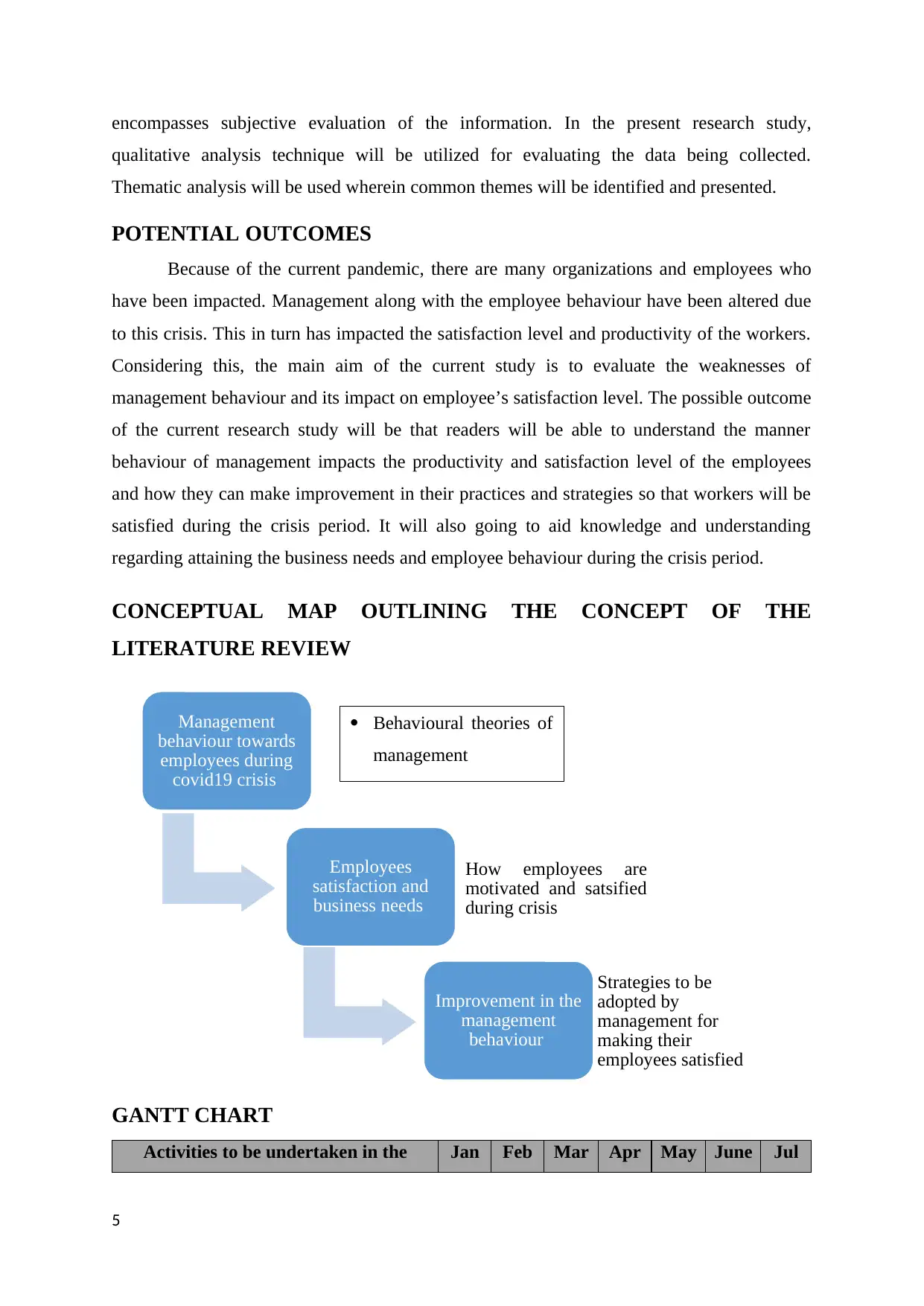
encompasses subjective evaluation of the information. In the present research study,
qualitative analysis technique will be utilized for evaluating the data being collected.
Thematic analysis will be used wherein common themes will be identified and presented.
POTENTIAL OUTCOMES
Because of the current pandemic, there are many organizations and employees who
have been impacted. Management along with the employee behaviour have been altered due
to this crisis. This in turn has impacted the satisfaction level and productivity of the workers.
Considering this, the main aim of the current study is to evaluate the weaknesses of
management behaviour and its impact on employee’s satisfaction level. The possible outcome
of the current research study will be that readers will be able to understand the manner
behaviour of management impacts the productivity and satisfaction level of the employees
and how they can make improvement in their practices and strategies so that workers will be
satisfied during the crisis period. It will also going to aid knowledge and understanding
regarding attaining the business needs and employee behaviour during the crisis period.
CONCEPTUAL MAP OUTLINING THE CONCEPT OF THE
LITERATURE REVIEW
GANTT CHART
Activities to be undertaken in the Jan Feb Mar Apr May June Jul
5
Management
behaviour towards
employees during
covid19 crisis
Employees
satisfaction and
business needs
How employees are
motivated and satsified
during crisis
Improvement in the
management
behaviour
Strategies to be
adopted by
management for
making their
employees satisfied
Behavioural theories of
management
qualitative analysis technique will be utilized for evaluating the data being collected.
Thematic analysis will be used wherein common themes will be identified and presented.
POTENTIAL OUTCOMES
Because of the current pandemic, there are many organizations and employees who
have been impacted. Management along with the employee behaviour have been altered due
to this crisis. This in turn has impacted the satisfaction level and productivity of the workers.
Considering this, the main aim of the current study is to evaluate the weaknesses of
management behaviour and its impact on employee’s satisfaction level. The possible outcome
of the current research study will be that readers will be able to understand the manner
behaviour of management impacts the productivity and satisfaction level of the employees
and how they can make improvement in their practices and strategies so that workers will be
satisfied during the crisis period. It will also going to aid knowledge and understanding
regarding attaining the business needs and employee behaviour during the crisis period.
CONCEPTUAL MAP OUTLINING THE CONCEPT OF THE
LITERATURE REVIEW
GANTT CHART
Activities to be undertaken in the Jan Feb Mar Apr May June Jul
5
Management
behaviour towards
employees during
covid19 crisis
Employees
satisfaction and
business needs
How employees are
motivated and satsified
during crisis
Improvement in the
management
behaviour
Strategies to be
adopted by
management for
making their
employees satisfied
Behavioural theories of
management
Paraphrase This Document
Need a fresh take? Get an instant paraphrase of this document with our AI Paraphraser
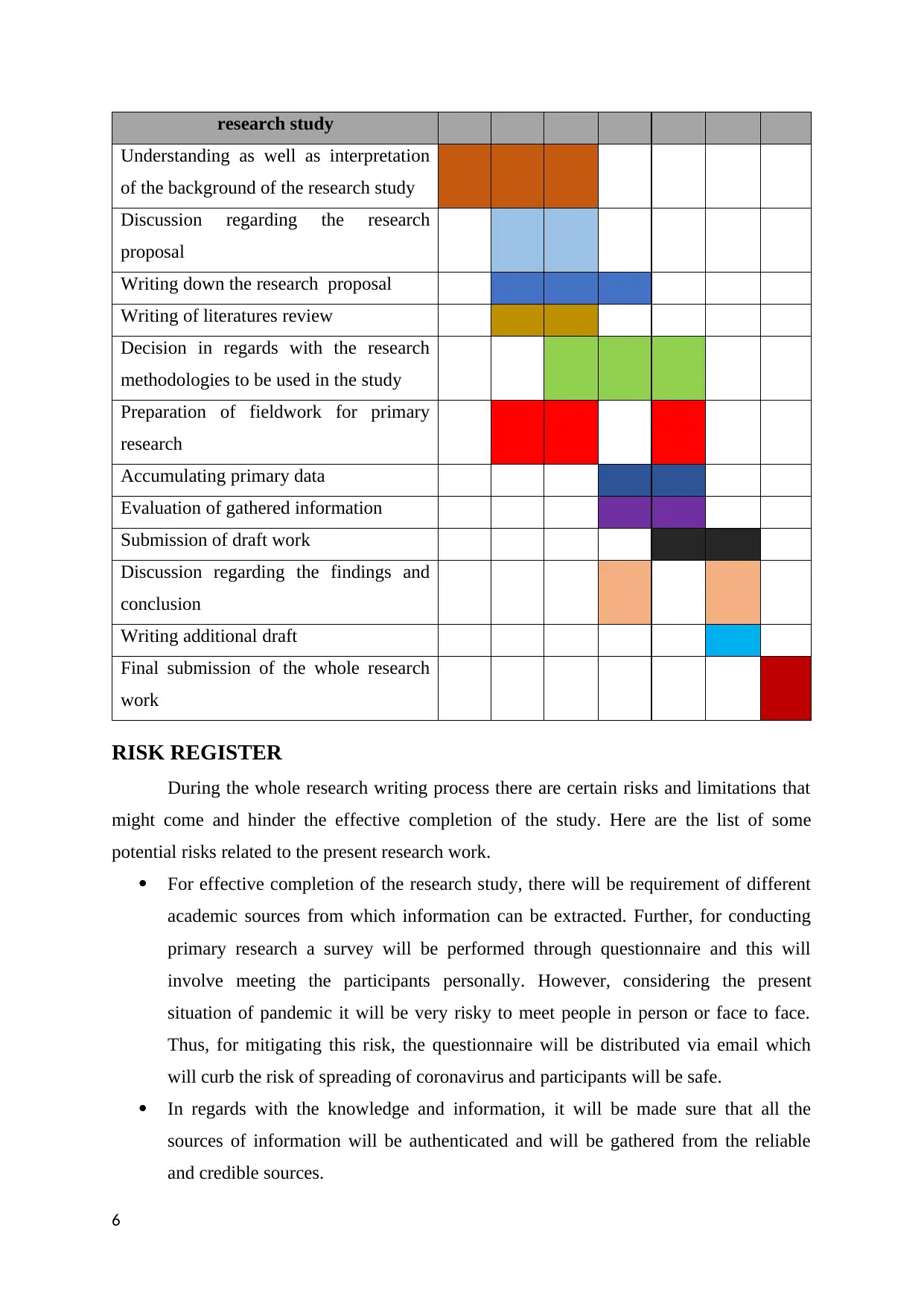
research study
Understanding as well as interpretation
of the background of the research study
Discussion regarding the research
proposal
Writing down the research proposal
Writing of literatures review
Decision in regards with the research
methodologies to be used in the study
Preparation of fieldwork for primary
research
Accumulating primary data
Evaluation of gathered information
Submission of draft work
Discussion regarding the findings and
conclusion
Writing additional draft
Final submission of the whole research
work
RISK REGISTER
During the whole research writing process there are certain risks and limitations that
might come and hinder the effective completion of the study. Here are the list of some
potential risks related to the present research work.
For effective completion of the research study, there will be requirement of different
academic sources from which information can be extracted. Further, for conducting
primary research a survey will be performed through questionnaire and this will
involve meeting the participants personally. However, considering the present
situation of pandemic it will be very risky to meet people in person or face to face.
Thus, for mitigating this risk, the questionnaire will be distributed via email which
will curb the risk of spreading of coronavirus and participants will be safe.
In regards with the knowledge and information, it will be made sure that all the
sources of information will be authenticated and will be gathered from the reliable
and credible sources.
6
Understanding as well as interpretation
of the background of the research study
Discussion regarding the research
proposal
Writing down the research proposal
Writing of literatures review
Decision in regards with the research
methodologies to be used in the study
Preparation of fieldwork for primary
research
Accumulating primary data
Evaluation of gathered information
Submission of draft work
Discussion regarding the findings and
conclusion
Writing additional draft
Final submission of the whole research
work
RISK REGISTER
During the whole research writing process there are certain risks and limitations that
might come and hinder the effective completion of the study. Here are the list of some
potential risks related to the present research work.
For effective completion of the research study, there will be requirement of different
academic sources from which information can be extracted. Further, for conducting
primary research a survey will be performed through questionnaire and this will
involve meeting the participants personally. However, considering the present
situation of pandemic it will be very risky to meet people in person or face to face.
Thus, for mitigating this risk, the questionnaire will be distributed via email which
will curb the risk of spreading of coronavirus and participants will be safe.
In regards with the knowledge and information, it will be made sure that all the
sources of information will be authenticated and will be gathered from the reliable
and credible sources.
6

There are chances of some health issues of the participants due to spread of pandemic
which might impact collection of responses for primary research.
Last but not the least, there might be issues pertaining to prioritization as well as
conceptualization of tasks which are required to be carried out.
7
which might impact collection of responses for primary research.
Last but not the least, there might be issues pertaining to prioritization as well as
conceptualization of tasks which are required to be carried out.
7
⊘ This is a preview!⊘
Do you want full access?
Subscribe today to unlock all pages.

Trusted by 1+ million students worldwide
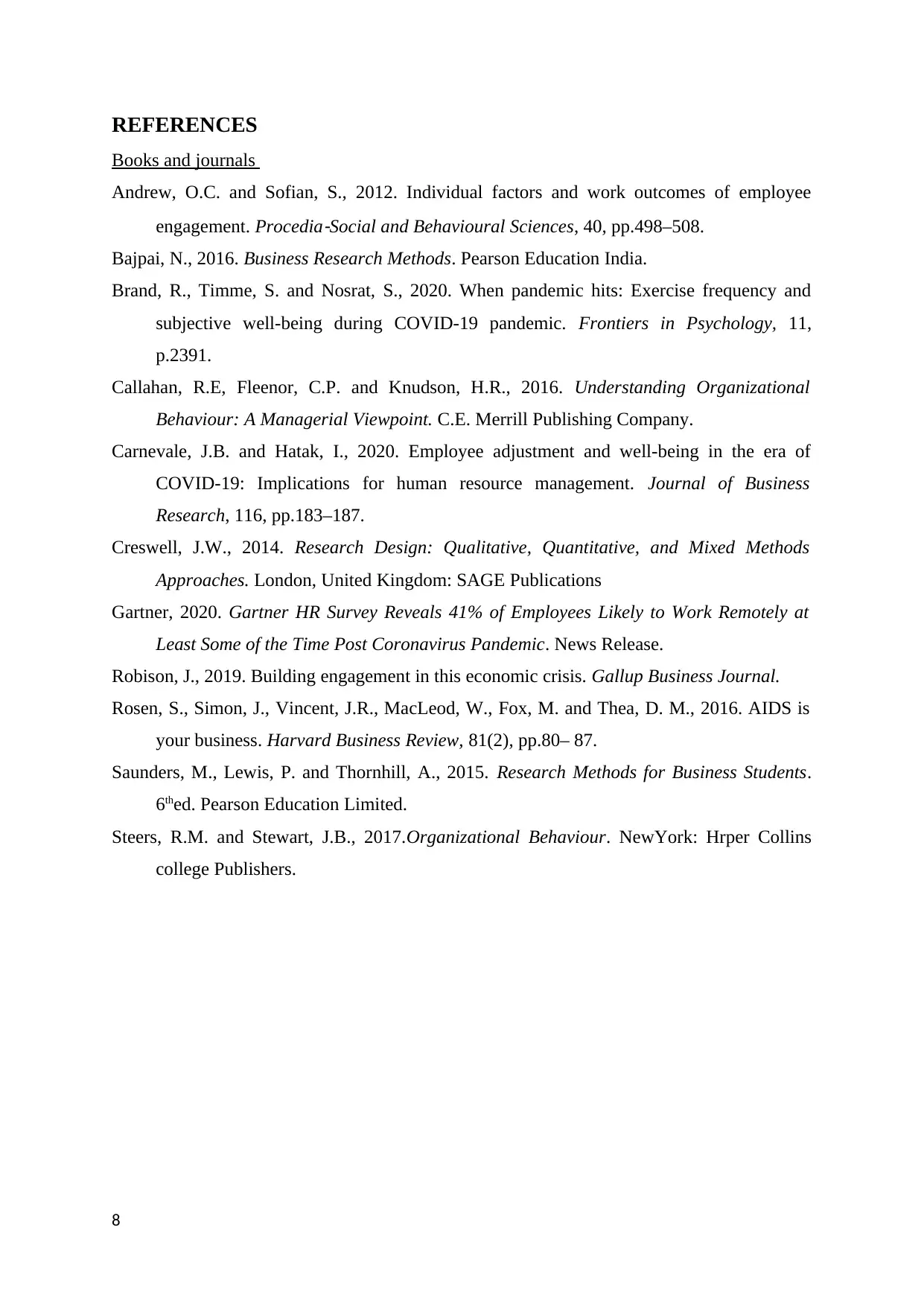
REFERENCES
Books and journals
Andrew, O.C. and Sofian, S., 2012. Individual factors and work outcomes of employee
engagement. Procedia
‐Social and Behavioural Sciences, 40, pp.498–508.
Bajpai, N., 2016. Business Research Methods. Pearson Education India.
Brand, R., Timme, S. and Nosrat, S., 2020. When pandemic hits: Exercise frequency and
subjective well-being during COVID-19 pandemic. Frontiers in Psychology, 11,
p.2391.
Callahan, R.E, Fleenor, C.P. and Knudson, H.R., 2016. Understanding Organizational
Behaviour: A Managerial Viewpoint. C.E. Merrill Publishing Company.
Carnevale, J.B. and Hatak, I., 2020. Employee adjustment and well-being in the era of
COVID-19: Implications for human resource management. Journal of Business
Research, 116, pp.183–187.
Creswell, J.W., 2014. Research Design: Qualitative, Quantitative, and Mixed Methods
Approaches. London, United Kingdom: SAGE Publications
Gartner, 2020. Gartner HR Survey Reveals 41% of Employees Likely to Work Remotely at
Least Some of the Time Post Coronavirus Pandemic. News Release.
Robison, J., 2019. Building engagement in this economic crisis. Gallup Business Journal.
Rosen, S., Simon, J., Vincent, J.R., MacLeod, W., Fox, M. and Thea, D. M., 2016. AIDS is
your business. Harvard Business Review, 81(2), pp.80– 87.
Saunders, M., Lewis, P. and Thornhill, A., 2015. Research Methods for Business Students.
6thed. Pearson Education Limited.
Steers, R.M. and Stewart, J.B., 2017.Organizational Behaviour. NewYork: Hrper Collins
college Publishers.
8
Books and journals
Andrew, O.C. and Sofian, S., 2012. Individual factors and work outcomes of employee
engagement. Procedia
‐Social and Behavioural Sciences, 40, pp.498–508.
Bajpai, N., 2016. Business Research Methods. Pearson Education India.
Brand, R., Timme, S. and Nosrat, S., 2020. When pandemic hits: Exercise frequency and
subjective well-being during COVID-19 pandemic. Frontiers in Psychology, 11,
p.2391.
Callahan, R.E, Fleenor, C.P. and Knudson, H.R., 2016. Understanding Organizational
Behaviour: A Managerial Viewpoint. C.E. Merrill Publishing Company.
Carnevale, J.B. and Hatak, I., 2020. Employee adjustment and well-being in the era of
COVID-19: Implications for human resource management. Journal of Business
Research, 116, pp.183–187.
Creswell, J.W., 2014. Research Design: Qualitative, Quantitative, and Mixed Methods
Approaches. London, United Kingdom: SAGE Publications
Gartner, 2020. Gartner HR Survey Reveals 41% of Employees Likely to Work Remotely at
Least Some of the Time Post Coronavirus Pandemic. News Release.
Robison, J., 2019. Building engagement in this economic crisis. Gallup Business Journal.
Rosen, S., Simon, J., Vincent, J.R., MacLeod, W., Fox, M. and Thea, D. M., 2016. AIDS is
your business. Harvard Business Review, 81(2), pp.80– 87.
Saunders, M., Lewis, P. and Thornhill, A., 2015. Research Methods for Business Students.
6thed. Pearson Education Limited.
Steers, R.M. and Stewart, J.B., 2017.Organizational Behaviour. NewYork: Hrper Collins
college Publishers.
8
1 out of 10
Related Documents
Your All-in-One AI-Powered Toolkit for Academic Success.
+13062052269
info@desklib.com
Available 24*7 on WhatsApp / Email
![[object Object]](/_next/static/media/star-bottom.7253800d.svg)
Unlock your academic potential
Copyright © 2020–2025 A2Z Services. All Rights Reserved. Developed and managed by ZUCOL.





